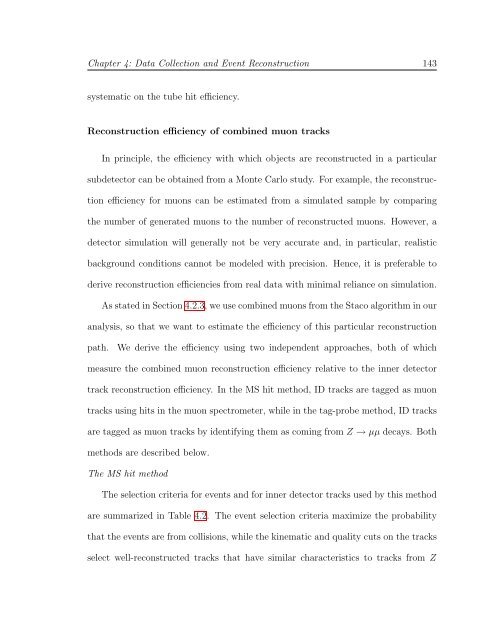Measurement of the Z boson cross-section in - Harvard University ...
Measurement of the Z boson cross-section in - Harvard University ...
Measurement of the Z boson cross-section in - Harvard University ...
You also want an ePaper? Increase the reach of your titles
YUMPU automatically turns print PDFs into web optimized ePapers that Google loves.
Chapter 4: Data Collection and Event Reconstruction 143<br />
systematic on <strong>the</strong> tube hit efficiency.<br />
Reconstruction efficiency <strong>of</strong> comb<strong>in</strong>ed muon tracks<br />
In pr<strong>in</strong>ciple, <strong>the</strong> efficiency with which objects are reconstructed <strong>in</strong> a particular<br />
subdetector can be obta<strong>in</strong>ed from a Monte Carlo study. For example, <strong>the</strong> reconstruc-<br />
tion efficiency for muons can be estimated from a simulated sample by compar<strong>in</strong>g<br />
<strong>the</strong> number <strong>of</strong> generated muons to <strong>the</strong> number <strong>of</strong> reconstructed muons. However, a<br />
detector simulation will generally not be very accurate and, <strong>in</strong> particular, realistic<br />
background conditions cannot be modeled with precision. Hence, it is preferable to<br />
derive reconstruction efficiencies from real data with m<strong>in</strong>imal reliance on simulation.<br />
As stated <strong>in</strong> Section 4.2.3, we use comb<strong>in</strong>ed muons from <strong>the</strong> Staco algorithm <strong>in</strong> our<br />
analysis, so that we want to estimate <strong>the</strong> efficiency <strong>of</strong> this particular reconstruction<br />
path. We derive <strong>the</strong> efficiency us<strong>in</strong>g two <strong>in</strong>dependent approaches, both <strong>of</strong> which<br />
measure <strong>the</strong> comb<strong>in</strong>ed muon reconstruction efficiency relative to <strong>the</strong> <strong>in</strong>ner detector<br />
track reconstruction efficiency. In <strong>the</strong> MS hit method, ID tracks are tagged as muon<br />
tracks us<strong>in</strong>g hits <strong>in</strong> <strong>the</strong> muon spectrometer, while <strong>in</strong> <strong>the</strong> tag-probe method, ID tracks<br />
are tagged as muon tracks by identify<strong>in</strong>g <strong>the</strong>m as com<strong>in</strong>g from Z → µµ decays. Both<br />
methods are described below.<br />
The MS hit method<br />
The selection criteria for events and for <strong>in</strong>ner detector tracks used by this method<br />
are summarized <strong>in</strong> Table 4.2. The event selection criteria maximize <strong>the</strong> probability<br />
that <strong>the</strong> events are from collisions, while <strong>the</strong> k<strong>in</strong>ematic and quality cuts on <strong>the</strong> tracks<br />
select well-reconstructed tracks that have similar characteristics to tracks from Z















